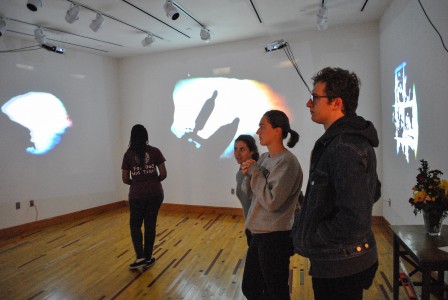
Jack Dunnington’s ’16 exhibit “Remote” opened in the Smith Gallery on Tuesday, Oct. 7. The show is comprised of a series of images projected onto the walls. Each series of photos begins with a snapshot featuring people from a historically marginalized culture. The image becomes distorted as the snapshots are quickly projected onto the otherwise-bare walls. Dunnington achieved this variation by taking a photo of the original image on a computer screen. He repeated this process as the new images twisted and exhibited new colors as a result of the distortion.
Dunnington, an art and anthropology double major, cites the photography of Native Americans by Edward S. Curtis as part of the inspiration for his artwork.
“There’s a tradition in anthropology, and it’s entering mainstream culture, of salvage photography, of capturing images of marginalized cultural groups with the expectation they will be driven out by global processes,” Dunnington said. “It’s deplorable to frame people as endangered animals at a time when they are being exploited.”
Dunnington said that Curtis’s work imposed a Eurocentric viewpoint on his Native American subjects by representing them as the European ideal of a Native American tribe: the noble savage. Though Dunnington’s exhibit makes use of the photographs that may contribute to the further marginalization of these people, Dunnington said that the spread of the message outweighs the negatives.
“I don’t have any direct experience with the trials these people go through, but it was a choice between making this or being passively complicit,” Dunnington said. “I realized that the show is more about that I can’t escape my identity as a member of an exploitative culture and group, so in the exhibit I’m taking on the role of the salvage photographer. Those images were the most powerful way I could communicate but I feel like there has to be a way to evoke that without becoming an agent of appropriation.”
Despite the potential negative aspects of his art exhibit, Dunnington intends the exhibit to be for anyone who consumes images, but particularly anthropologists.
“Anthropologists have to constantly ask themselves about anthropology. [Being an anthropologist] requires a constant reexamination of your motivations: Are you just trying to further your academic career when you’re conducting ethnography? You’re coming in and asking people to accept your presence with no composition,” Dunnington said.
Dunnington considers his work to be an example of “soft activism,” meaning that it encourages the viewer to be aware of the issues of exploitation and appropriation. Dunnington said that current photojournalists such as Jimmy Nelson, who photographs indigenous people much like Curtis did in the 1900s, depend on the distribution of their work through social and political mediums such as Facebook and newspaper to communicate their messages.
“I hope it makes people ask questions, but in the end the audience is still very limited. I like the Smith Gallery,” Dunnington said. “It’s not a gallery space in that people have to look at it. It’s not limited to people who would choose to go to a gallery.”


















































